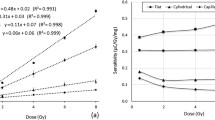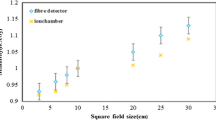Abstract
The maximum rate at which the light dose may be delivered during interstitial photodynamic therapy (PDT) has been measured for several types of delivery fibre. Measurements of light irradiance at the skin surface overlying subcutaneous experimental tumours were made during interstitial irradiation by 200Μm core diameter fibres whose output ends were either plane-cut or 5 mm long cylindrical diffusers. For plane-cut fibres, a rapid fall in light transmission, due to blood coagulation at the fibre tip, was observed at output powers greater than 229 mW and 104 mW in tumours with and without photosensitizer, respectively. Such a rapid fall was not observed with cylindrical diffusing fibres at output powers up to 1 W.
In the clinical use of PDT the fibre output power is held constant at a level below which thermal effects may occur. In a second study, therefore, the irradiance at the skin surface was monitored for this treatment regime. A decrease in light transmission during treatment was observed. Plane-cut fibres showed a greater decrease than cylindrical diffusing fibres and for a given fibre type, non-photosensitized tumours showed a greater decrease than photosensitized tumours. For cylindrical diffusing fibres at output powers of 150 mW or less there was a 9% decrease in irradiance measured at the skin surface during the first 1000 s of treatment. The decrease was larger (30–40%) for fibre output powers in the range 200–300 mW.
Similar content being viewed by others
References
Driver I, Feather JW, King PR, Dawson JB. Coagulation of blood at the tip of optical fibres used for light delivery in photodynamic therapy.Lasers Med Sci 1989,4:125–9
UK Co-ordinating Committee on Cancer Research. UKCCCR guidelines for the welfare of animals in experimental neoplasia. UKCCCR, 20 Park Crescent, London W1N 4AL. 1988.
Feather JW, King PR, Driver I, Dawson JB. A method for the construction of disposable cylindrical diffusing fibre optic tips for use in photodynamic therapy.Lasers Med Sci 1989,4:229–35
Marijnissen JPA, Star WM. Quantitative light dosimetry in vitro and in vivo.Lasers Med Sci 1987,2:235–42
Author information
Authors and Affiliations
Rights and permissions
About this article
Cite this article
Feather, J.W., Driver, I., King, P.R. et al. Light delivery to tumour tissue through implanted optical fibres during photodynamic therapy. Laser Med Sci 5, 345–350 (1990). https://doi.org/10.1007/BF02032590
Received:
Issue Date:
DOI: https://doi.org/10.1007/BF02032590




